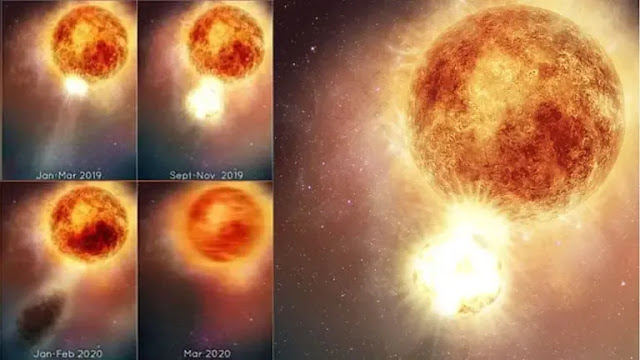A team of experts says the star Betelgeuse is
recovering from a massive, “never-before-seen” surface mass ejection that
obscured it.
When the bright red supergiant star Betelgeuse exploded in 2019, the Hubble Space Telescope and other observatories were there to see it.
Through this surface mass ejection, Betelgeuse discharged 400 billion times more mass than the Sun during a typical coronal mass ejection, a regular event in which the Sun sheds part of its outer atmosphere, called the corona.
However, this wasn't some kind of supernova ending.
Betelgeuse
Betelgeuse is one of the most prominent stars in the Milky Way, part of the constellation Orion, and apparently continues to act like a normal star, and may even be recovering.
After analyzing the 2019 data, astronomers concluded that this is behavior we've never seen before in a normal star.
Data from NASA's Hubble Space Telescope and several
other observatories
Data from NASA's Hubble Space Telescope and several
other observatories.
Andrea Dupree , a researcher at the Center for Astrophysics , a collaboration between the Smithsonian Astrophysical Observatory and the Harvard College Observatory , said in a statement :
“Betelgeuse is still doing very unusual things right now. The inside is like jumping.”
The 2019 surface mass ejection exploded atop Betelgeuse, and recovery from something so devastating is a rocky road.
Dupree said:
“We have never seen such a large mass ejection from the surface of a star before. We are seeing something happening that we don’t fully understand. It’s a completely new phenomenon that we can observe and directly resolve the surface details with Hubble. We are watching stellar evolution in real time.”
Could a supernova occur?
The 2019 surface mass ejection exploded atop
Betelgeuse.
The 2019 surface mass ejection exploded atop
Betelgeuse.
Betelgeuse is so prominent in the Milky Way that such a magnificent event not only provides a series of world firsts in the study of stars, but can continue to provide a baseline of knowledge about how stars act before, during and after a shallow mass ejection.
Since this event occurs before any definitive supernova event – and there is no evidence that one will happen any time soon – there may be plenty of time to observe the progression.
Researchers now believe the 2019 event came from a convective plume more than a million kilometers deep inside the star.
The shocks and pulsations ripped off a chunk of the photosphere, leaving a cold surface beneath a cloud of dust.
This fractured chunk, several times heavier than the Moon, dimmed the star so much that the difference could be seen without a telescope.
The supergiant star's 400-day pulsation rate has disappeared, and Dupree says the star's interior convection cells that drive the pulsation may be "going off-kilter like a washing machine."
Hubble data suggests the outer layer may have
recovered, but the surface is “bouncing around like a sheet of jelly as the
photosphere rebuilds.”



.png)
%20(1)%20(2).jpg)
0 Comments